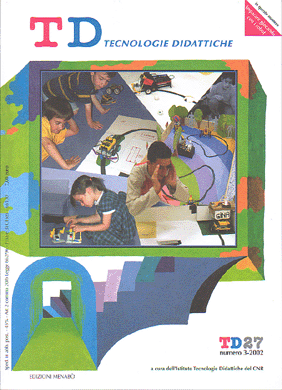Build and program robots
Main Article Content
Abstract
Article Details
Authors who publish with this journal agree to the following terms:
- Authors retain copyright and grant the journal right of first publication with the work simultaneously licensed under a Creative Commons CC BY 4.0 Attribution 4.0 International License.
- Authors are able to enter into separate, additional contractual arrangements for the non-exclusive distribution of the journal's published version of the work (e.g., post it to an institutional repository or publish it in a book), with an acknowledgement of its initial publication in this journal.
- Authors are permitted and encouraged to post their work online (e.g., in institutional repositories or on their website) prior to and during the submission process, as it can lead to productive exchanges, as well as earlier and greater citation of published work (See The Effect of Open Access)
References
Clark A. (1997), Being There: Putting Body, Brain, and World Together Again, The MIT Press, Cambridge, MA (trad. it. Dare Corpo alla Mente, Mc-Graw Hill, Milano, 1999).
D’Amico A., Guarnera M., Cardaci M. (2001), SAVIO: Sistema Automatizzato di Valutazione dell’Intelligenza Operatoria. Descrizione e Sperimentazione pilota dello strumento, Bollettino di Psicologia Applicata, 235.
Järvinen E.-M. (1998), LEGO / Logo learning environment in technology education and in the context of mathematical end scientific subjects, http://edtech.oulu.fi/T3/co urses/wp13/material/legologo. htm
Kafai Y., Resnick M. (eds) (1996), Constructionism in Practice: Designing, Thinking, and Learning in a Digital World, Lawrence Erlbaum Associates, Hillsdale, NJ.
Lund H. H. (1999), Robot Soccer in Education, Advanced Robotics Journal, 13 (8), pp. 737-752.
Martin F. (1992), Building Robots to Learn Design and Engineering, in Proceedings of the 1992 Frontiers in Education Conference, Nashville, Tennessee, November 1992.
Martin F. (1994), Circuits to Control: Learning Engineering by Designing LEGO Robots, Ph. D. Thesis, MIT, Cambridge, MA.
Martin F. (1997), An open letter to professors Jake Mendelssohn and David Ahlgren, esteemed founders of the Trinity college Fire-Fighting robot competition, April 23th, http://www.handyboard.co m/misc/fredm423.txt
Miglino O., Lund H. H., Cardaci M. (1999), Robotics as an Educational Tool, Journal of Interactive Learning Research, 10 (1), pp. 25-48.
Papert S. (1980), Mindstorms: Children, Computers, and Powerful Ideas, Basic Books, New York.
Papert S. (1986), Constructionism: A New Opportunity for Elementary Science Education, Proposal to the National Science Foundation.
Piaget J., Inhelder B. (1966), La psychologie de l’enfant, P.U.F., Paris.
Raven J. C. (1947), CPM Coloured Progressive Matrices, Organizzazioni Speciali, Firenze.
Rey A. (1968), Reattivo della Figura Complessa. Manuale, Organizzazioni Speciali, Firenze.
Resnick M. (1988), MultiLogo: A Study of Children and Concurrent Programming, MS thesis, MIT, Cambridge, MA.
Resnick M. (1989), LEGO, Logo, and Life, in Langton C. (ed) Artificial Life,Addison- Wesley, Redwood City, CA.
Resnick M. (1994), Turtles, Termites, and Traffic Jams, The MIT Press, Cambridge, MA.
Resnick M., Ocko S., Papert S. (1988), LEGO, Logo, and Design, Children’s Environments Quarterly, vol. 5, n. 4.
Vygotsky L.S. (1962), Thought and language, The MIT Press, Cambridge, MA.

